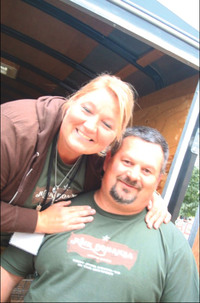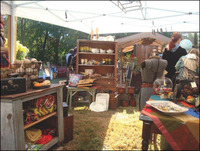Buying and selling antiques is in Cammie Metheny’s blood.
The Laurel, Neb., woman remembers, as a child, going with her parents to auction after auction buying up items long past their prime, blowing off the dust and finding them a new home. She didn’t much care for the family pastime when she was very young, but over time, she developed a passion that rivaled that of her parents’.
Today, Cammie and her husband, David, have found a way to make this sideline their life’s work.
“This is what we do for a living now,” Cammie said. “This is the fourth year neither of us have had a regular job, where we’re treating this as a business and not as a hobby.”
The Methenys own 106 Vintage Co., which mostly supplies store owners around the Midwest with vintage items, original or remade. They also take part in eight or so sales a year in the surrounding states where they meet additional store owners and potential customers. Recently, Cammie and David purchased Coleridge, Neb.’s former opera house that they’re renovating into a showroom—uncovering 18-foot tin ceilings, wood floors and wall frescoes depicting cities from New York to California.
“We bought it, because we needed to expand the business and thought we’d use it for storage,” Cammie said. “But when we began to renovate, it just snowballed from there. Right now, we’re painstakingly steaming paint off the frescoes. I did one last night, and it took five hours.”
While the Methenys continue to deal in antiques, Cammie’s specialty the past 20 years is more in remaking vintage items for modern use, also known as repurposing or, in today’s terms: upcyling.
“Upcycling is taking something you currently have and looking at it in a different way and giving something a new life in a new way,” she said, like turning old fencing into baskets, house trim into boxes, banister spindles into lamp bases and croquet mallets into coat hangers. Another favorite this time of the year is adding an insulator to an old bed spring and using it as a planter for a spring flower.
Cammie’s start in upcycling began at the former Iron Springs store in Yankton, where her repurposing skills were put to work making crafts. Then a few years ago, she and David attended a sale in Minneapolis that consisted entirely of upcycled items. The sale was so exclusive that it took two years for the Methenys to gain the opportunity to become a vendor. Their first sale was successful enough to land them a contract to be part of a sale every three months.
Cammie and David had made the transition from a hobby to a full-fledged business.
“It’s about following what your passion is and doing what you love,” Cammie said. “If you do that, it works really well, because that’s what drives you, because it’s not like a job then. Yes, you need to get a paycheck, but it’s nice to do what you love and get paid for it.”
In addition to her and David’s business, Cammie is a contributor to Flea Market Style magazine, where she creates the projects for the project stories.
Attending sales throughout the year puts her in a good position to see what people are buying. Cammie and David just attended a sale on April 10-12 in Minneapolis that attracted 17,000 people.
“It’s huge,” Cammie said. “It’s a movement, really.”
Virtually anything could be repurposed, from keys to a windmill, though some items are trendier than others. Depression and carnival glass is no longer as valuable as it once was. Another item that Cammie avoids for upcycling projects is fake flowers.
Materials that are proving to be very popular lately include architectural items, keys, picture frames, furniture, maps, globes, anatomy and other charts, and anything rusty or made of wire.
Seasonal items, like gardening items in the spring or holiday items in the fall, are also recurring favorites.
“You have to evolve with what people want and how trends change,” Cammie said. “What was worth huge amounts of money 20 years ago may not be worth anything now.”
While repurposing is nothing new, upcycling seems to be growing in popularity in last few years.
Cammie thinks it may be partly due to the Green and Sustainable Living movements, but also because older items are simply harder to find.
“People are realizing that if we keep destroying old things, we won’t have them anymore,” she said.
For many people, vintage items have invaluable sentimental value.
“Part of it is the history connected to the item,” Cammie said.
“It reminds people of their grandma or maybe something from their childhood.”
Even for items not tied to a specific memory, most antiques make one-of-a-kind upcycling projects. Each has weathered and worn a little differently.
“Think about an old, blue bottle all cloudy inside,” Cammie said. “It took 100 years of being buried in the dirt to create that color.”
Finally, upcycled vintage materials are often more durable than what can be found in the store.
“You can’t buy anything now that will last that long,” Cammie said. “What you find in the stores now, those things aren’t made to last for years and years. When these older items were made, they were each crafted by hand with great care put into the design and workmanship. They were made to last.”
Looking for more examples of upcycling in the Yankton area?
Look no further than local county 4-H fairs this summer where youth will be exhibiting many projects with repurposing in mind, from recycled clothing to refurnished furniture to remade home and outdoor items.
“While it might not be termed ‘upcycling’ to us, it is for the most part what the kids are doing with their projects,” said Andrew Jensen, 4-H Youth Program Advisor for Yankton, Clay and Union counties. “I have seen some really great ideas from our 4-H youth, everything from recycled cups and plates made into bird feeders to giant dragonflies made from stair banisters and license plates to even a wind chime made from snowmobile parts.”




